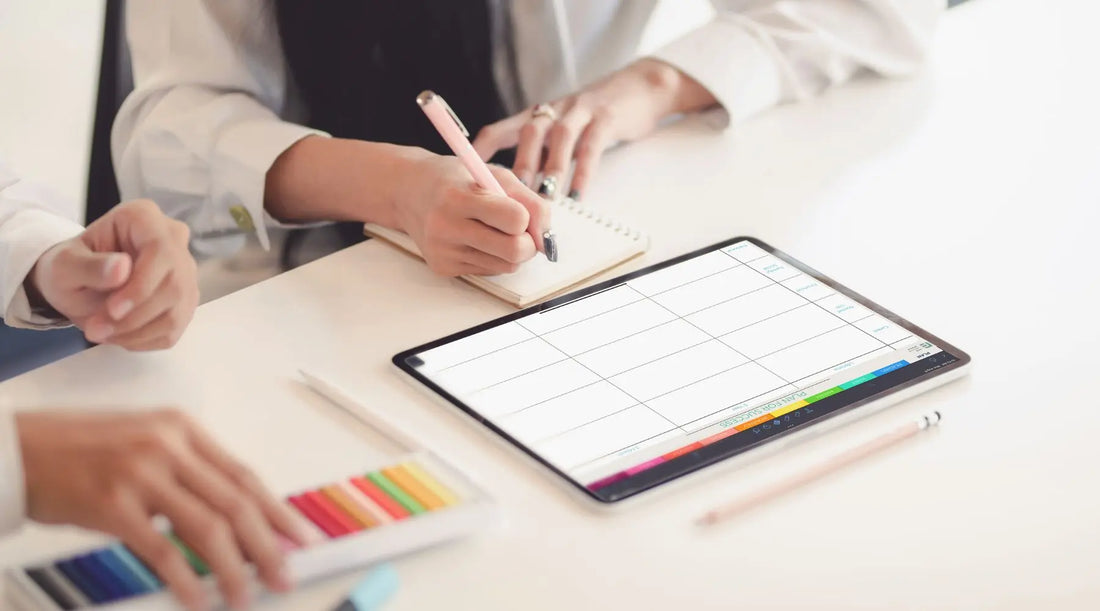
How to Use a Planner Effectively: Tips and Ideas You'll Actually Use
Share
Even though you have a planner and you're using it doesn't mean you're using it right.
Hard to believe but yes, you can use a personal planner wrong, and your results will show. When you use it the right way, you'll boost your productivity and meet your goals.
Today, we will learn how to use a personal planner correctly.

Why you want to use a planner effectively
There are so many reasons you want to use your planner effectively that we could list them for days. If you want to 10x your life, you'll understand why.
- It helps you manage your time better
- It helps you stay organized
- Remember important dates
- Prioritize important tasks
- Gives you a sense of accomplishment
- It helps you save time
Choosing the right type of planner
Before you can get started, you have to choose the right planner. When it comes to style, doesn't matter if it is a paper planner or digital.
If you're new to the planning world, it's best to start with a general personal planner or daily planner. They allow broad planning and will fit your daily routine.
As you get used to the daily schedule of using a planner and following it, you should look into more niche planners to dive into your goals more. Adding a fitness or finance planner to your arsenal.
We have a more detailed write-up about the different types of planners available.
How to Use a Planner for Beginners
These planning tips will help you plan more and make it so you actually use your planner instead of letting it collect dust.
Follow these few steps to stay on track and accomplish all of your yearly goals.

Step 1: Set Your Planning Goals.
A good planner should focus on your goals. If you wanted a planner for only tasks, you could use a piece of paper and write a list with the tasks for the day and be ok.
Your planner should help you plan. First, you write down all your goals. When you have your big goals figured out, you can start breaking them down into smaller, more manageable goals and tasks.
To take your goals to the next level, make sure you're using the SMART goal method.
Step 2: Make To-Do Lists.
From your smaller goals and task lists, you want to make to-do lists. You want to plan these by month, then by week, and finally have a task list to do each day.
These to-do lists are going to be what you focus on each day. You don't want them too big, and you don't want them too small. Enough to work and be successful.
Make sure you prioritize your tasks so you're only working on the most important ones. People often spend time on pointless tasks or "busy work" and this distracts you from your goals.

Step 3: Create a schedule
You want to take the next step now which is creating your schedule. You can do a high-level schedule with a monthly planning section but one of the most popular scheduling tools is a "week at a glance" spread.
These weekly pages let you plan the weeks ahead but still have plenty of room for each day of the week. They are typically full-page spreads that break the days down with an hourly view.
Time blocking is a common method to take your scheduling to the next level. It's a simple method where you create specific time blocks for certain tasks to type of work. Work on it during the allocated time only and then move on to your next time block at the end.
Step 4: Use your planner every day
Your planner and plan are worthless if you don't put them to work every day. When you don't use it, things tend to get out of control.
If you created proper to-do lists and set a good schedule, you
As you do the tasks every day, you will notice you're accomplishing your weekly goals and finally, your monthly goals as well.

Other ways to use a planner
For the most success, you want your planner to focus on your goals. From the setting of your goals to the breakdown and plan to reach your goals, your planner should revolve around goals.
But that is not all it is good for. There are a few other things you can use your planner for to make the most of it.
A good planner should have a notes section for notes and reminders. Our planners all include a lot of room for notes. If you use a digital planner, it's very easy to add note pages wherever you need and as many as you want.
Another useful tip is to track important deadlines with the calendar. Events and appointments make a difference with your schedule so you need to keep track of these and it's easier to plan around while you keep them in your planner.
You can also keep track of your habits. Habits are the key to a happy, healthy, and successful life. Most of our planners include a habit tracker so you can track and see your progress.

How to use your planner final thoughts
Using your planner the right way is the difference between giving up on your planner and crushing your goals. It's not hard to use and if you take time each day to use it, you'll be 10x more productive and successful.
I recommend you try these tips for a week and let the results speak for themselves. You'll notice the difference right away.

